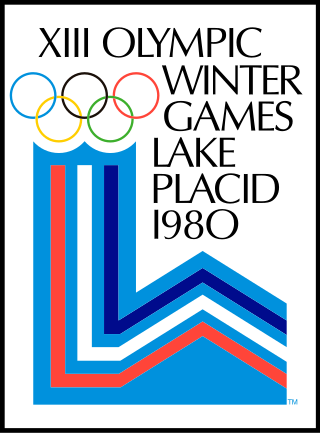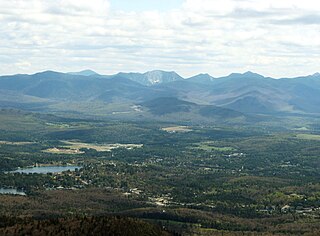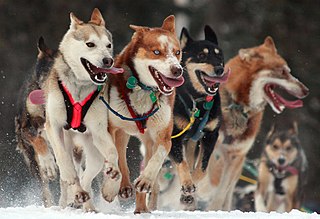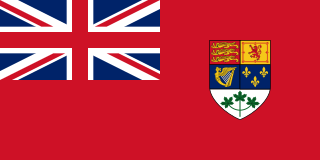
Bobsleigh or bobsled is a winter sport in which teams of 2 to 4 athletes make timed runs down narrow, twisting, banked, iced tracks in a gravity-powered sleigh. International bobsleigh competitions are governed by the International Bobsleigh and Skeleton Federation.

The 1980 Winter Olympics, officially the XIII Olympic Winter Games and also known as Lake Placid 1980, were an international multi-sport event held from February 13 to 24, 1980, in Lake Placid, New York, United States.

Lake Placid is a village in the Adirondack Mountains in Essex County, New York, United States. In 2020, its population was 2,205.

The 1932 Winter Olympics, officially known as the III Olympic Winter Games and commonly known as Lake Placid 1932, were a winter multi-sport event in the United States, held in Lake Placid, New York, United States. The games opened on February 4 and closed on February 13. It was the first time the Winter Games were held outside of Europe and the first of four Winter Olympics held in the United States; Lake Placid hosted again in 1980.

The Iditarod Trail Sled Dog Race, more commonly known as The Iditarod, is an annual long-distance sled dog race held in Alaska in early March. It travels from Anchorage to Nome. Mushers and a team of between 12 and 16 dogs, of which at least 5 must be on the towline at the finish line, cover the distance in 8–15 days or more. The Iditarod began in 1973 as an event to test the best sled dog mushers and teams but evolved into today's highly competitive race.

A sled dog is a dog trained and used to pull a land vehicle in harness, most commonly a sled over snow.

Sled dog racing is a winter dog sport most popular in the Arctic regions of the United States, Canada, Russia, Greenland and some European countries. It involves the timed competition of teams of sled dogs that pull a sled with the dog driver or musher standing on the runners. The team completing the marked course in the least time is judged the winner.

Mushing is a sport or transport method powered by dogs. It includes carting, pulka, dog scootering, sled dog racing, skijoring, freighting, and weight pulling. More specifically, it implies the use of one or more dogs to pull a sled, most commonly a specialized type of dog sled on snow, or a rig on dry land.

The Yukon Quest, formally the Yukon Quest 1,000-mile International Sled Dog Race, is a sled dog race scheduled every February since 1984 between Fairbanks, Alaska, and Whitehorse, Yukon, switching directions each year. Because of the harsh winter conditions, difficult trail, and the limited support that competitors are allowed, it is considered the "most difficult sled dog race in the world", or even the "toughest race in the world"—"even tougher, more selective and less attention-seeking than the Iditarod Trail Sled Dog Race." The originator envisioned it as "a race so rugged that only purists would participate."
Joe Redington, Senior was an American dog musher and kennel owner, who is best known as the "Father of the Iditarod Trail Sled Dog Race", a long distance sled dog race run annually from the Anchorage area to Nome, Alaska.
Dorothy G. Page was best known as "Mother of the Iditarod Trail Sled Dog Race", the 1,049-mile dog sled race across the U.S. state of Alaska.
The Junior Iditarod Sled Dog Race, or Jr. Iditarod, is a 148- to 158-mile sled dog race for mushers between the ages of 14 through 17, which is patterned after the 1,150-mile Iditarod Trail Sled Dog Race that is said to be 1,049 miles (1,688.2 km). The race is held outside Anchorage in the U.S. state of Alaska, and was the first long-distance race for juvenile mushers.

Rachael Scdoris /səˈdɔərɪs/ is an American dog musher and cross country runner who in 2006 became the first legally blind person to complete the 1,049+ mile Iditarod Trail Sled Dog Race across the U.S. state of Alaska.

Skijoring is a winter sport in which a person on skis is pulled by a horse, a dog, another animal, or a motor vehicle. The name is derived from the Norwegian word skikjøring, meaning "ski driving". Although skijoring is said to have originated as a mode of winter travel, it is currently primarily a competitive sport.

Leonhard "Sepp" Seppala was a Norwegian-Kven-American sled dog breeder, trainer and musher who with his dogs played a pivotal role in the 1925 serum run to Nome, and participated in the 1932 Winter Olympics. Seppala introduced the work dogs used by Native Siberians at the time to the American public; the breed came to be known as the Siberian Husky in the English-speaking world. The Leonhard Seppala Humanitarian Award, which honors excellence in sled dog care, is named in honour of him.
Colonel Norman Dane Vaughan was an American dogsled driver and explorer whose first claim to fame was participating in Admiral Byrd's first expedition to the South Pole. He also ran dog teams in a professional capacity as part of a search and rescue unit in World War II, in sporting events like the Olympics and the Iditarod Trail Sled Dog Race, and in three Presidential Inauguration ceremonies.

Canada competed at the 1932 Winter Olympics in Lake Placid, United States. Canada has competed at every Winter Olympic Games.
Emile St. Godard was a Canadian dog musher and dog sled racer from Winnipeg, Manitoba. He was a renowned musher in the 1920s and 1930s, with much of his fame derived from racing Leonard Seppala and his victory in the demonstration race at the 1932 Winter Olympics at Lake Placid, New York. In 1956 he became the only dog sled racer to be entered into Canada's Sports Hall of Fame.

The Race to the Sky is a long-distance sled dog race held annually in Montana. There are several divisions offered at different distances. The longest race was originally a 500-mile (800 km) race but is currently 350 miles (560 km). It is a qualifying race for the Iditarod Trail Sled Dog Race and is sometimes called "The Iditarod of the Lower 48."














